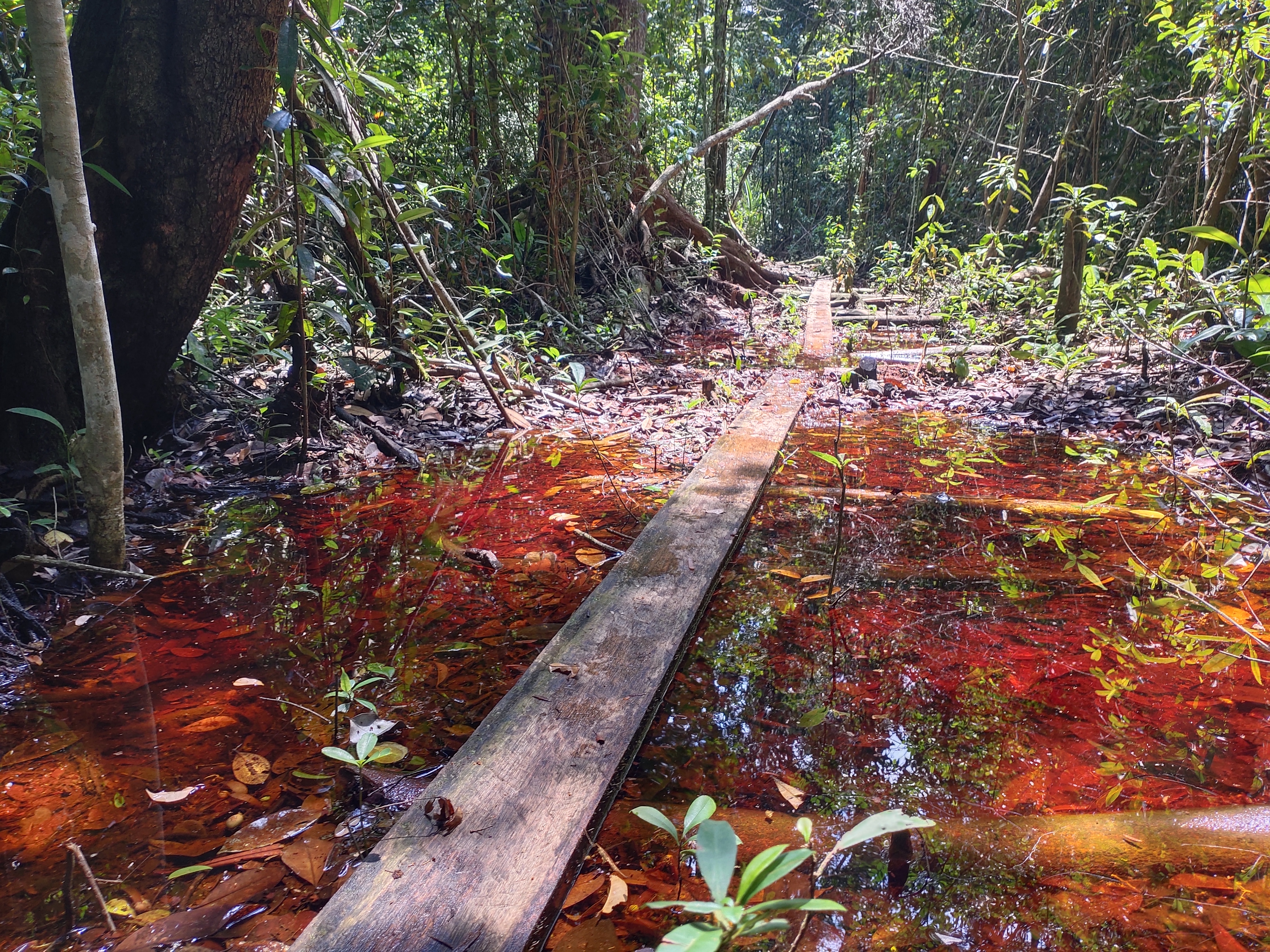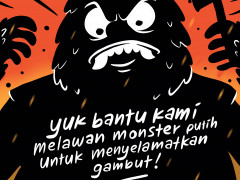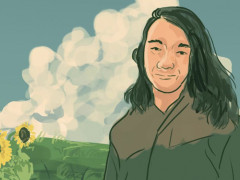Illustrator Competition #PerburuanMonsterPutih
By AdminChallenges to Protect Peatlands in the Village Forest Scheme in Rawa Mekar Jaya, Riau
The Threat of Deforestation and Illegal Logging
The threat of deforestation due to forest fires, illegal logging, and land conversion into plantations continues to haunt peatlands and forests in Siak District. The website of Perkumpulan Elang, an environmental NGO based in Riau, stated that deforestation and forest fires have caused 80% of peat degradation in Siak District.
Perkumpulan Elang said that deforestation is mostly due to activities in Industrial Plantation Forests (HTI), oil palm plantations, agriculture lands, and settlements, while the second factor that has caused forest degradation is forest fires. 383,331 hectares or around 80% of the 479,485 hectares of peatlands in Siak District are degraded.
This condition threatens one of the large peatlands with good forest stands in Siak District, which is the Zamrud National Park Ecosystem.
Illegal logging continues to increase in the area surrounding the Zamrud National Park, including the Social Forestry area under the Rawa Mekar Jaya Village Forest scheme in Sungai Apit Subdistrict, Siak District.
This concern was conveyed by Ahmad Nawawi, Secretary of the Rawa Mekar Jaya Village Forest Management Agency (LPHD). Illegal encroachment has occurred since the last few years but becomes more intense during the COVID-19 pandemic. The increase occurred because employment opportunities in the cities were reduced so that many people returned to the villages and did whatever work as long as they made money.
“The intensity of illegal logging is very high. It's horrible. Because there are still many Meranti, Punak, Redwood, Balam, Bintangor, and Suntai which are expensive timbers. The east and south parts are prone to illegal logging. The loggers don't get there by land. They get there through the Rawa River which is connected to the Zamrud Lake," said Nawawi.
Social Forestry to preserve forest areas
The residents do not want to stay silent about the illegal logging targeting high-value timber in the Rawa Mekar Jaya Village Forest. In 2015, when the Jokowi government intensified the Social Forestry program, the residents wanted to propose the forest in their village.
After they struggled with the proposal since 2015, on 7 January 2021, the villagers of Rawa Mekar Jaya finally received a Decree on Social Forestry for Village Forest covering an area of 3,433 hectares. The area is smaller than their proposed 4,970 hectares. The decree was handed over by President Jokowi virtually.
“Before submitting the proposal for social forestry, we saw the Village Forest scheme as a solution to anticipate the destruction of the Rawa Mekar Jaya peat forest. This is what we are working on," said Nawawi to Pantau Gambut.
The Rawa Mekar Jaya Village Forest is part of the peat swamp ecosystem which is bordered by the Zamrud National Park on the upstream and flanked by oil palm plantation and industrial forest plantation on the downstream. When proposing for the Social Forestry program, the residents conducted field observations and found that the peat depth was up to 13 meters.
“After we got the Decree, we disseminated the information together with village government officials and the community. And before the last Ramadan, there was a team from the Village Forest Management Agency (LPHD) who went to the field to check the coordinate points in the Decree," said Nawawi back in mid-July.
Challenges of Social Forestry in Rawa Mekar Jaya Village
But during field visits, he saw the threat of illegal logging is getting higher. From the data he collected, there are at least a dozen loggers in, both individual and group operations, who continue to push into the Village Forest area.
“I saw a group of 6 people and each of them had a chainsaw. It is not like land clearing for industrial forest plantation or oil palm plantation that clear all the stands, but the timbers that they take are quite valuable," he said.
Another challenge in protecting peatland in the village forest is land clearing. There is a plantation with four to five years old oil palms which covers an area of approximately 20 hectares. There is also a sago plantation in another part of the Village Forest which has been managed by the villagers for generations.
This condition was confirmed by Nurhadi Rahim, an extension worker for the Tasik Besar Serkap Forest Management Unit (KPH), who provides assistance after the permit was issued. The challenge was identified when his party together with LPHD conducted data collection to determine the forest cover and biophysical condition of the land. The results of this biophysical data collection will make it easier for LPHD to manage the areas within the protection block and utilization block.
“The data collection activity is not only to find out about the current situation, but also to identify potential conflicts in the future. Several people claimed to own the land there. We are still in the identification process to find a solution," Rahim told Pantau Gambut recently.
Regarding this ownership claim, it turns out that most of the lands are owned by people outside the village, and those lands are in the Village Forest area. Setiono, a non-governmental forestry extension worker who is also a resident of Sungai Rawa Village, said that the basis of those claims is Certificate of Land Compensation (Surat Keterangan Ganti Rugi) and Certificate of Land Ownership (Surat Keterangan Riwayat Kepemilikan Tanah). But after investigation, they found that these certificates were issued a decade ago when there was no village expansion.
“But the owner already knows about the Village Forest status, so there have been no activities since the Village Forest permit was issued. In the future, we will ask them to sit together to find a solution, so that we can preserve the village forest and the owner won’t suffer any loss,” said Setiono to Pantau Gambut. Rahim estimated that it will take a long time for verification and resolution. However, he saw that the LPHD management had already planned to hold a meeting to discuss it.
“I heard that a meeting will be held to discuss it. We estimate that half of the lands have been claimed by some people. There is no claim in the protection block. All the claims are in the utilization block. Almost half of the 3,000 hectares are claimed," said Rahim.
Regarding the resolution of the problem, Nawawi from LPHD Rawa Mekar Jaya said that they are currently marking the boundaries for zoning. This boundary marking is very important to inform other parties that the area already has a management permit, so we hope that illegal encroachment will decrease.
“We are currently preparing an annual work plan, including for the area protection scheme. But in this case, we hope to get help from other parties because we can’t do it by ourselves,” said Nawawi.
Meanwhile, Nawawi also sees an internal challenge of how to increase the capacity of LPHD personnel. Almost all personnel have a main job as the breadwinner of the family, so they can't manage the forest full time.
The second thing is the limited capacity and skills of the personnel who need to carry out a fairly important task of protecting the forests and improving people's welfare through the Village Forest scheme.
Considering these challenges, Nawawi hopes to get assistance from various parties to strengthen the organization and to carry out the village forest protection program.
Recently, BPSKL (Center for Social Forestry and Environmental Partnership) assisted LPHD in getting IDR 50 million funding from Bank Pesona. This fund will be used for planting three types of forest plants, i.e. 1,000 areca nut trees, 1,000 sago trees, and 500 sugar palms, which will be planted on 20 hectares of land.
“We are a group of farmers and laborers who live in poverty. We hope for as much assistance as possible from these NGO facilitators, especially in developing strategies for utilizing non-timber forest products, because we can't manage it on our own. As for surveillance, it’s difficult for us to anticipate conflicts because we can't be like the police,” said Nawawi.




